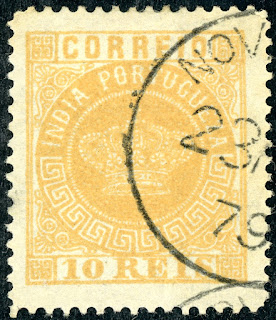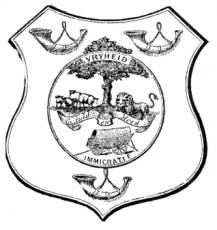Portuguese India 1880 Scott 69 50r dark blue"Portuguese Crown"
Fournier Forgery
Into the Deep Blue
The "Portuguese Crown" issues for the Portuguese colonies offer a challenge for the WW collector.
For Angola, they are found in 12 1/2 Perf (thin to medium paper), Perf 13 1/2, Perf 14 (25r rose), and Perf 12 1/2 (thick paper): altogether 29 bolded numbers in Scott for nine denominations. Reprints (1885, 1905) of these issues on smooth white chalky paper or ivory paper were also produced.
There are also some minor number color variations.
But all the above is not the real problem. Unfortunately, there are plentiful forgeries. The major players were Fournier and Spiro, but there were others also.
Let's talk about the Fournier forgeries of the "Portuguese Crown" issues for Angola and the other Portuguese colonies.
As it turns out, Fournier first used the Angola "Portuguese Crown" issue for his forgery template. That consequently makes it more difficult to tell Fournier forgeries apart from the genuines for Angola, as they appear ( without close scrutiny and certain signs) to be identical. There will be much more about this later with the next post.
For the other Portuguese colonies, the design of the genuines are somewhat different than Angola's design. But Fournier kept some of the attributes of his Angola forgeries for the other Portuguese colonies forgeries, which makes it easier to spot a Fournier forgery for the other Portuguese colonies.
Let's take a look at a genuine and a Fournier Forgery for Portuguese India, as an example.
Portuguese India 1977 Scott 61 50r yellow green
"Portuguese Crown"; Genuiine
1) Note the solid green circular tablet (with India Portugueza script on it) is
below the lower horizontal line of the "Correio" tablet. All genuines of the Portuguese colonies (except Angola) have this characteristic.
2) The clamshell design in the upper right corner (below horizontal line that separates "Correio") has all it's lines intact, creating seven lobes without a line break. This is characteristic for all genuines of the Portuguese colonies (except Angola).
3) The Maltese cross (which has a definite Maltese cross shape) on the crown has a white button in the center, and is attached to the globe below.
4) The line of crown pearls on the sides of the crown are more angular in shape for the Portuguese colonies stamps than the "rounder" line of pearls found for the Angola stamps. This will become clearer as we show more examples.
Now, let's look at a Portuguese India Fournier forgery...
Portuguese India 1877 Scott 60 40t blue
"Portuguese Crown"
Fournier Forgery
The following signs are valid for the Fournier forgeries for all Portuguese colonies, except Angola- which is a special case.
1) Note the solid blue circular tablet (with India Portugueza script on it) intersects heavily with the lower horizontal line of the "Correio" tablet. This is a sign that this is a Fournier forgery for all Portuguese colonies, except Angola. Also note the right upper clamshell appears to also touch the line.
These signs are easily used to separate out the genuines from the Fournier forgeries for all Portuguese colonies, except Angola.
(For Angola, both the genuines and the Fournier forgeries show the circular solid line below the "Correios" tablet to intersect heavily with the lower horizontal line of the "Correios" tablet. Therefore, this sign is not helpful for Angola. The reason this sign is helpful for the other Portuguese colonies is because the genuine design was changed, but Fournier did not change his, after he made the forgery template for Angola.)
2) The clamshell design in the upper right corner (below horizontal line that separates "Correio") has a line broken, specifically creating a large center lobe with a partial center-left thick open line, leaving six intact lobes. This is a sign of a Fournier forgery for Portuguese colonies, excepting Angola. (Angola's situation is complex and a bit confusing. We will address it later with the next post.)
3) The "Maltese" cross on the crown does not have a "Maltese" shape, and is smaller, and sometimes deformed. There is no white button in the center, rather a "hole". Often the cross is detached a bit from the globe. These are all signs we may be dealing with a Fournier forgery. These signs can be found for all the Portuguese colonies AND Angola.
4) For the Fournier forgery, the line of crown pearls on the sides of the crown are "rounder", compared to the angular line shape of the crown pearls in the genuines. This is true for all the Portuguese colonies stamps, except Angola.
I think I will show another example of a Portuguese colony "Crown" stamp vs a Fournier forgery, just to make sure we know the differences. (Remember these differences are valid for all Portuguese colonies, EXCEPT Angola.) Let's look at Mozambique...
Mozambique 1877 Scott 6 25r rose
"Portuguese Crown"
Genuine
1) Note the solid red circular tablet (with Mocambique script on it) is
below the lower horizontal line of the "Correio" tablet, or just touches it for a short while. All genuines of the Portuguese colonies (except Angola) have this characteristic.
2) The clamshell design in the upper right corner (below horizontal line that separates "Correio") has all it's lines intact, creating seven lobes without a line break. This is characteristic for all genuines of the Portuguese colonies (except Angola). There is no touching of the horizontal line of the "Correio" tablet.
3) The Maltese cross (which has a definite Maltese cross shape) on the crown has a white button in the center, and is attached to the globe below.
4) The line of crown pearls on the sides of the crown are more angular in shape for the Portuguese colonies stamps than the "rounder" line of pearls found for the Angola stamps. This will become clearer as we show more examples.
Mozambique 1877 Scott 8 40r blue
"Portuguese Crown"
Fournier Forgery
The following signs are valid for the Fournier forgeries for all Portuguese colonies, except Angola- which is a special case.
1) Note the solid blue circular tablet (with Mocambique script on it) intersects heavily with the lower horizontal line of the "Correio" tablet. This is a sign that this is a Fournier forgery for all Portuguese colonies, except Angola. Also note the right upper clamshell appears to also touch the line.
These signs are easily used to separate out the genuines from the Fournier forgeries for all Portuguese colonies, except Angola.
(For Angola, both the genuines and the Fournier forgeries show the circular solid line below the "Correios" tablet to intersect heavily with the lower horizontal line of the "Correios" tablet. Therefore, this sign is not helpful for Angola. The reason this sign is helpful for the other Portuguese colonies is because the genuine design was changed, but Fournier did not change his, after he made the forgery template for Angola.)
2) The clamshell design in the upper right corner (below horizontal line that separates "Correio") has a line broken, specifically creating a large center lobe with a partial center-left thick open line. (This is obscured here because of the cancel). This is a sign of a Fournier forgery for Portuguese colonies, excepting Angola. (Angola's situation is complex and a bit confusing. We will address it later with the next post.)
3) The "Maltese" cross on the crown does not have a "Maltese" shape, and is smaller, and sometimes deformed. There is no white button in the center, rather a "hole". Often the cross is detached a bit from the globe. These are all signs we may be dealing with a Fournier forgery. These signs can be found for all the Portuguese colonies AND Angola.
4) For the Fournier forgery, the line of crown pearls on the sides of the crown are "rounder", compared to the angular line shape of the crown pearls in the genuines. Also, some of the pearls may be smaller. This is true for all the Portuguese colonies stamps, except Angola.
Portuguese India 1877 Scott 57 10r yellow
"Portuguese Crown"
Fournier Forgery
Out of the Blue
I hope this introduction to the "Crown" Fournier forgeries for the Portuguese colonies, other than Angola, was helpful. Actually, in most cases, other than Angola, determining these Fournier forgeries is not too difficult.
Also, I should mention that Ron of Classic Stamp Forgeries website fame, has recently updated his "Portuguese Crown" Genuines & Forgeries post. He has lots more examples of Fournier forgeries and other forgeries for the Portuguese colonies. Check it out!
But we have left the challenging determinations for the next several posts, where we will be looking at Angola. There, we not only encounter the Fournier forgeries, but also Spiro forgeries, and other more obscure forgery examples. Then there are the "borderline" examples where it is difficult to tell for sure if genuine/forgery.
Stay tuned. 😎
Comments appreciated!






























